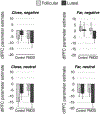Brain activation during emotion regulation in women with premenstrual dysphoric disorder
- PMID: 29145910
- PMCID: PMC9196139
- DOI: 10.1017/S0033291717003270
Brain activation during emotion regulation in women with premenstrual dysphoric disorder
Abstract
Background: Difficulties in regulating emotions are linked to the core symptoms of premenstrual dysphoric disorder (PMDD). We therefore investigated the neural substrates of emotion-regulation problems in women with PMDD.
Methods: On the basis of self-evaluations over 2 months on the Daily Record of Severity of Problems, eligible participants were assigned to two groups: PMDD and control (18 per group). Functional magnetic resonance imaging (fMRI) and a well-validated task were used to assess brain function during emotion regulation. Participants were tested twice, once during the follicular (asymptomatic) and once in the late luteal (symptomatic) phase of the menstrual cycle.
Results: Women with PMDD gave higher ratings of negative affect in the luteal phase than in the follicular phase, and compared with healthy control participants during the luteal phase. A region-of-interest fMRI analysis indicated that during the late luteal phase, women with PMDD had hypoactivation in right dorsolateral prefrontal cortex (dlPFC) during all conditions of the emotion-regulation task, not only in the contrast that isolated emotion regulation. An exploratory whole-brain, voxel-wise analysis showed that women with PMDD had less activation in the precentral gyrus during the luteal phase than the follicular phase, and less activation in the postcentral gyrus compared with control participants.
Conclusions: During the luteal phase of the menstrual cycle, women with PMDD experience difficulty regulating emotions. Hypoactivation in the right dlPFC may contribute to this problem, but may be related more generally to other affective symptoms of PMDD. Hypofunction in the right pre- and postcentral gyri warrants additional study.
Keywords: Premenstrual dysphoric disorder; PMDD; emotion regulation; fMRI; menstrual cycle; neuroendocrinology.
Conflict of interest statement
Figures





Similar articles
-
Brain reactivity to emotional stimuli in women with premenstrual dysphoric disorder and related personality characteristics.Aging (Albany NY). 2021 Aug 4;13(15):19529-19541. doi: 10.18632/aging.203363. Epub 2021 Aug 4. Aging (Albany NY). 2021. PMID: 34349039 Free PMC article.
-
Emotional fronto-cingulate cortex activation and brain derived neurotrophic factor polymorphism in premenstrual dysphoric disorder.Hum Brain Mapp. 2014 Sep;35(9):4450-8. doi: 10.1002/hbm.22486. Epub 2014 Feb 25. Hum Brain Mapp. 2014. PMID: 24615932 Free PMC article.
-
Trait-related changes in brain network topology in premenstrual dysphoric disorder.Horm Behav. 2020 Aug;124:104782. doi: 10.1016/j.yhbeh.2020.104782. Epub 2020 Jun 17. Horm Behav. 2020. PMID: 32470339
-
Effects of GABA active steroids in the female brain with a focus on the premenstrual dysphoric disorder.J Neuroendocrinol. 2018 Feb;30(2). doi: 10.1111/jne.12553. J Neuroendocrinol. 2018. PMID: 29072794 Review.
-
Neuroimaging the Menstrual Cycle and Premenstrual Dysphoric Disorder.Curr Psychiatry Rep. 2015 Oct;17(10):77. doi: 10.1007/s11920-015-0619-4. Curr Psychiatry Rep. 2015. PMID: 26272540 Review.
Cited by
-
Grey matter correlates of affective and somatic symptoms of premenstrual dysphoric disorder.Sci Rep. 2022 Apr 9;12(1):5996. doi: 10.1038/s41598-022-07109-3. Sci Rep. 2022. PMID: 35397641 Free PMC article.
-
Emotion-focused therapy for women with premenstrual dysphoric disorder: a randomized clinical controlled trial.BMC Psychiatry. 2024 Jul 11;24(1):501. doi: 10.1186/s12888-024-05681-8. BMC Psychiatry. 2024. PMID: 38992619 Free PMC article. Clinical Trial.
-
Biomarkers of reproductive psychiatric disorders.Br J Psychiatry. 2025 Jun;226(6):352-368. doi: 10.1192/bjp.2025.134. Epub 2025 Jun 20. Br J Psychiatry. 2025. PMID: 40538358 Free PMC article. Review.
-
The Prominent Role of the Temporal Lobe in Premenstrual Syndrome and Premenstrual Dysphoric Disorder: Evidence From Multimodal Neuroimaging.Front Psychiatry. 2022 Jun 28;13:954211. doi: 10.3389/fpsyt.2022.954211. eCollection 2022. Front Psychiatry. 2022. PMID: 35836663 Free PMC article. Review.
-
Resting-state functional connectivity in women with PMDD.Transl Psychiatry. 2019 Dec 11;9(1):339. doi: 10.1038/s41398-019-0670-8. Transl Psychiatry. 2019. PMID: 31827073 Free PMC article.
References
-
- Andersson J, Jenkinson M and Smith S (2007) Non-linear registration, aka Spatial normalisation. FMRIB Technical Report.
-
- American Psychiatric Association (2013). Diagnostic and Statistical Manual of Mental Disorders (5th ed.). Washington, DC: Author.
-
- Bannbers E, Gingnell M, Engman J, Morell A, Comasco E, Kask K, Garavan H, Wikstrom J and Sundstrom Poromaa I (2012) The effect of premenstrual dysphoric disorder and menstrual cycle phase on brain activity during response inhibition. Journal of Affective Disorders 142, 347–350. - PubMed
Publication types
MeSH terms
Grants and funding
LinkOut - more resources
Full Text Sources
Other Literature Sources
Medical

